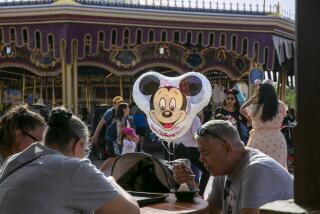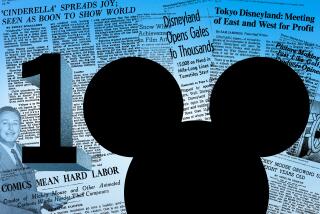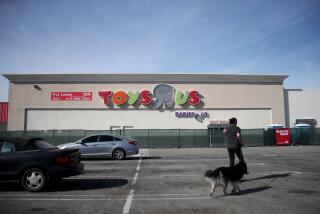Big Battle for a Silly Old Bear
Once upon a time--well, actually 78 years ago--a British playwright named Alan Alexander Milne scribbled some lighthearted verses about a boy and his constant companion, a dimwitted bear who couldn’t get enough honey.
Winnie the Pooh was an immediate sensation. Milne spent the rest of his life trying to escape the suffocating shadow of his cuddly creation. Even today, people can’t get enough of that silly old bear--or his honey.
Pooh has become a $1 billion-a-year industry for Walt Disney Co., which acquired rights to the Milne characters in 1961. Disney has put Pooh and his forest friends in movies and computer software, on its ABC television network and on videotapes and DVDs. There’s Pooh fruit juice and Tigger telephones. Pooh Beanie Babies dressed in satiny feng shui robes and leather-like black biker jackets. Piglet cookie jars. Pooh chopsticks. A toaster that plays a Pooh jingle while toasting bread in a pattern that resembles the bear’s face.
At Tokyo Disneyland, visitors wait two hours to ride Pooh’s Honey Hunt--the park’s most popular attraction.
Last year, Disney paid $352 million to buy the remaining Pooh rights from various Milne heirs in England. Yet there remains one threat to the entertainment giant’s Pooh empire. Her name is Shirley Slesinger Lasswell.
Lasswell is an 81-year-old widow who lives in Beverly Hills and gets around in a chauffeured silver Mercedes with a 3-foot Pooh doll buckled in beside her. Lasswell and her daughter inherited merchandising rights to Milne’s characters half a century ago from Lasswell’s first husband, a literary agent.
In 1961, Lasswell turned those rights over to Disney for a share of the merchandising revenue. Since then, she and her daughter, Patricia Slesinger, have collected $66 million in Pooh riches. But they are unhappy. They contend that Disney has cheated them out of at least $200 million in royalties and are asking a court to terminate their Disney contract so they can shop their Pooh rights to other companies.
Their 11-year-old lawsuit, one of the longest-running sagas in Los Angeles Superior Court, is set for trial in March.
For Disney, the stakes are enormous. The company recently warned shareholders that “damages could total as much as several hundred million dollars and adversely impact ... any future exploitation” of Pooh, Piglet, Tigger and Eeyore.
It has been a nasty fight. In the early 1990s, Disney workers shredded boxes of old files sought by Lasswell and her daughter, including one labeled “Winnie the Pooh, Legal Problems.” Disney says the papers were irrelevant, but a judge last year fined the company $90,000 and ruled that the jury would be told about the destruction of evidence if the case was to go to trial.
Both sides agree that Lasswell and her daughter are entitled to Disney royalties on a wide range of Pooh products. The dispute centers on whether their rights extend to videotapes, DVDs and computer software featuring the Milne menagerie.
Disney’s lead attorney, Daniel Petrocelli, dismisses the case as “overreaching” and “rooted in greed.”
Lasswell resents the suggestion that she and her daughter are gold diggers: “We’re not grab, grab, grab. We’re low-key people,” she said.
Back in the ‘50s, Lasswell marketed upscale Pooh toys and children’s clothing to department stores, helping to revive the franchise years before Disney became involved. Lasswell believes that she has been key to developing the Pooh brand.
“We wouldn’t be spending all these millions on lawyers all of these years if we just wanted more money,” she said. “We just want what we’re entitled to: no more, no less.”
A Boy’s Stuffed Toys
A.A. Milne was one of Britain’s most popular playwrights in the early 1920s. At one point, five of his comedies were playing at the same time in London and New York.
In 1920, Milne and his wife, Daphne, had their only child, Christopher Robin Milne. They gave him stuffed toys, including a bear, a tiger, a kangaroo and a donkey whose neck grew limp from the boy’s affection. Mother and child would play together, creating stories and voices for the animals. Milne used this as inspiration for a 1924 poem about a boy and his teddy bear, and he later created the cast of “Winnie-the-Pooh,” published in 1926. The book’s hero was a boy named Christopher Robin.
The “bear of little brain” and his playmates had personalities and enduring charm. The simple line drawings of Ernest H. Shepard brought the characters to life. The four Pooh books have sold more than 50 million copies in 33 languages.
Milne was smothered by Pooh’s success. He fretted about being typecast as a children’s writer and grew uneasy about using his son’s name in the stories.
One of the first to see Pooh’s financial potential was Stephen Slesinger, a young New York literary agent. Slesinger established one of the first successful character licensing firms, acquiring rights to Tarzan and Charlie Chan. He helped create the Red Ryder comics and films and served as the agent for western writer Zane Grey.
In 1930, Slesinger sailed to England to secure from Milne the rights to sell Pooh merchandise in the U.S. and Canada. He agreed to pay Milne a $1,000 advance, plus royalties equal to 3% of the merchandising revenue. Two years later, Slesinger acquired the radio and television rights at a time when TV was still just a budding idea among a few engineers. During the Depression, Slesinger licensed Pooh toys and dishes, an RCA record narrated by Jimmy Stewart and a board game by Parker Bros.
By the mid-1930s, Milne was enjoying steady royalties from his Pooh books as well as Slesinger’s merchandise, but his literary career was in a painful slide. His novels and plays about marriage and murder mysteries flopped. Critics suggested that he return to children’s verses.
The very mention of Pooh often would make Milne shudder, said his biographer, Ann Thwaite. Milne wrote 530 pages of memoirs and mentioned the Pooh characters on just four.
“He spent five years writing the children’s books in a lifetime of being an author--more than 50 years,” Thwaite said. “He went on to write marvelous plays and stories, and nobody seemed to be the least bit interested in them.”
The Pooh stories also poisoned the relationship between Milne and his son.
Christopher Milne was continually teased for his role in the Pooh books. As an adult, he wrote that his father “had filched from me my good name and had left me with nothing but the empty fame of being his son.”
By the time A.A. Milne died in 1956, Christopher had rarely seen his father for years.
To escape his celebrity, Christopher and his wife moved to the English countryside and opened a small bookshop. Only once did he use his famous name--to lead a campaign against a 1980s oil- drilling project that threatened Britain’s Ashdown Forest, the real-life setting for Pooh’s Hundred Acre Wood. Christopher died in 1996, at 75.
Disney Shows Interest
By the 1940s, Walt Disney’s studio was enjoying the success of a string of animated films, including “Snow White and the Seven Dwarfs,” “Fantasia” and “Bambi.” Disney was scouting for other children’s stories to animate and took a keen interest in Pooh.
But Roy O. Disney, Walt’s brother and the financial brains of the company, uncovered a problem.
“A.A. Milne has certainly completely balled up his rights in Winnie the Pooh,” he wrote in a 1947 memo. “Milne has given to Slesinger not only rights to merchandising, but also rights for radio and television.... If we were to attempt to do anything with Winnie the Pooh, Slesinger is in a beautiful spot to either hold us up for an outrageous price or sit back and reap the rewards of our investment.”
Disney took a pass on Pooh.
About this time, Slesinger had his eye on Shirley Basso, a stunning showgirl 20 years his junior. In 1947, the doe-eyed brunet was a dancer in “Hellzapoppin!” on Broadway. One of the show’s producers introduced her to Slesinger.
“He was a little pixie, so sweet and so creative,” she recalled.
The couple flew to Las Vegas in 1948 to be married. Silent film actress Clara Bow was the maid of honor. The newlyweds honeymooned at Slesinger’s dude ranch in Colorado and split their time between a New York penthouse and a bungalow at the Hotel Bel-Air.
Slesinger died in 1953 while in Los Angeles producing a TV pilot based on the “Blondie” comic strip. He bequeathed his merchandising and licensing business to Shirley and their 1-year-old daughter, Patricia.
Within a few years, the stream of royalties began to dwindle. Shirley sold the Colorado ranch. She could no longer afford the Manhattan penthouse.
“I thought, ‘Now what do I do?’ But it was right there for me,” she said. “I decided to promote Pooh.”
She reread Milne’s books and wrote down verses to use in a new line of products. She designed Pooh postcards, stationery, wall hangings and oversize coloring books. She fired the Long Island, N.Y., firm that had been hand-stitching Pooh dolls for 20 years--she thought they weren’t “snuggly enough”--and hired other factories to churn out plusher products. She visited buyers at Lord & Taylor and Bonwit Teller in New York, Marshall Field & Co. in Chicago, Filene’s in Boston and Neiman Marcus in Dallas. Soon they were carrying her Pooh line of children’s apparel, pink pinafores and plastic-lined panties with Pooh quotations.
In 1960, Shirley got a call from Disney asking if she was interested in selling her Pooh rights. She was excited by the idea.
“I really went as far as I could go [with Pooh]. It was just me, not some huge company,” she said.
She reached a royalty agreement in 1961 with Disney that gave her 4% of the revenue on worldwide Pooh sales. Soon after, Shirley said, she met Walt Disney himself at the Waldorf-Astoria hotel in New York.
“He said, ‘Shirley, you won’t be sorry,’ ” she recalled.
In 1965, Disney struck a deal with Sears, Roebuck & Co. to sell Pooh merchandise designed by Disney. A year later, Disney released its first Pooh movie, with an Americanized Christopher Robin character. Ernest Shepard, Pooh’s original illustrator, pronounced the film “a travesty.”
Shirley remarried in 1964, to cartoonist Fred Lasswell, and moved with her husband and daughter to Tampa, Fla., where she drove a Cadillac with a “POOH 1” license plate.
The family’s Pooh royalties rose from $13,000 in 1967 to $89,000 by 1981, their attorneys said. Pooh money helped pay for Patricia Slesinger’s college education and her art history studies abroad.
Shirley’s doubts about Disney surfaced in 1981 while she was on a trip to Disney World in Florida. A self-described Pooh “shopaholic,” she went on a buying spree. Later, she compared her haul with Disney’s royalty statements and saw that many of the Pooh products were not listed. She hired a lawyer.
By then, Disney had turned Pooh into a global brand and wanted to streamline its character rights. Instead of having separate contracts with the Slesinger and Milne families, Disney wanted to bring all the deals under one contract.
In 1983, Shirley Lasswell, Christopher Milne and representatives of the Milne estate signed a new Disney contract. The deal trimmed the Slesinger family’s Pooh royalties from 4% to about 2% of what they expected to be a much larger revenue pie. It called for more detailed accounting of what was sold. Disney also paid Lasswell and her daughter $750,000 to resolve the dispute over past royalties.
The peace didn’t last long. By the late 1980s, videotapes were the rage, and Disney was busy putting Pooh movies and TV programs on video. In 1987, a lawyer for the Milne estate and Lasswell compared notes about Disney’s royalty payments. In one 12-month period, Disney paid the family more than $1 million in royalties on Pooh records and videotapes, plus $17,000 for computer software. Then royalties for those products suddenly dropped. For one six-month period in 1989, according to court records, Disney paid Lasswell and her daughter just $22.37 on software sales.
In 1990, Lasswell hired an auditor to review Disney’s books and concluded that the company had failed to keep complete sales records for Pooh merchandise for eight years. She and her daughter sued Disney in 1991. The next year, they received a $2.2-million “catch-up” payment to clear up discrepancies uncovered in the audit.
The current court case centers on whether videotapes, DVDs and software are covered by the 1983 royalty agreement. The family contends that Disney executives promised that videos and other emerging technologies would be included, even if they were not spelled out in the contract.
Disney says the Slesingers tried in 1983 to include videos in the deal and signed even after the company rejected the demand.
“The case boils down to whether they are entitled to be paid for all sorts of uses that are not covered by the contract,” said Petrocelli, the Disney attorney. “They say that when Winnie the Pooh is dancing down Main Street and hugs a kid, they ought to get a royalty from that. But the contract never gave them those rights.”
While the case dragged on, Pooh’s popularity exploded. In 1994, when Disney’s merchandise contract with Sears, Roebuck expired, the company launched a “Pooh initiative,” rolling out new lines of Pooh products, including wallpaper, bedsheets, snow globes and a “classic” line of stuffed dolls and novelties that more closely resemble Shepard’s original drawings.
Disney’s annual Pooh revenue rose from $100 million to more than $1 billion in just four years, Disney Chief Executive Michael Eisner told an investment conference in 1998.
Shirley Lasswell and daughter Patricia also have seen their Pooh wealth soar. It took 24 years for their total Pooh earnings to reach $1 million. Since filing their lawsuit, they have received $65 million in royalties.
Milne Estate Sells Rights
Last year, seeking to tie up legal loose ends in its Pooh royalty agreements, Disney bought all future rights from the Milne estate for $352 million. A Milne family trust distributed the money to four principal beneficiaries.
A London men’s club to which A.A. Milne once belonged received $88 million; the members decided to set up a scholarship fund for actors and writers. An additional $88 million went to the British boarding school that Milne attended as a boy. The Royal Literary Fund for struggling writers was given $132 million. The $44 million remaining was put in a trust named for Clare Milne, the author’s granddaughter, who has cerebral palsy; the trust pays benefits to her and other disabled people.
Now, the Pooh holdouts are down to Shirley Lasswell and her daughter.
Patricia Slesinger, 49, says the legal battle with Disney has been emotionally draining but also educational.
She has learned about the role her parents played in building the Pooh merchandise empire. Slesinger, who lives in Los Angeles and runs her own business publishing glossy shopping guides for high-end hotels, has spent hours on EBay hunting for treasures licensed by her father or designed by her mother.
Two years ago, Disney published a 176-page coffee-table book about the history of Pooh. Slesinger was offended to find no mention of her family.
“Everybody has done a great job” developing the Pooh brand, she said. “But don’t try to erase us out of history.”
*
Times researcher Robin Mayper contributed to this report.
*
(BEGIN TEXT OF INFOBOX)
The Pooh Money Pot
Since British author A.A. Milne created the Winnie the Pooh characters in the 1920s, the stories have continued to generate enormous wealth:
* Book publishers Dutton Children’s Books in the U.S. and Egmont in Denmark receive proceeds from the sales of A.A. Milne’s children’s classics. The books have sold more than 50 million copies worldwide. But that income is dwarfed by the $1 billion a year that Walt Disney Co. receives in worldwide sales of Pooh merchandise, including toasters, breakfast cereal, computer software and videos.
* Shirley Slesinger Lasswell inherited the merchandising rights to Pooh from her husband, a literary agent. In 1961, she sold her rights to Disney for a share in product royalties. Lasswell and her daughter, Patricia Slesinger, have received $66 million in Pooh royalties. But they are suing Disney, alleging fraud and breach of contract, and claim they have been cheated out of $200 million to $300 million in royalties.
* Last year, the Milne estate in England received a lump-sum payment of $352 million from Disney for future Pooh merchandise and motion picture rights. That money was then distributed to various Milne beneficiaries:
* $132 million to the Royal Literary Fund to help struggling writers.
* $88 million to the Westminster School, a British boarding school Milne attended.
* $88 million to the Garrick Club, an exclusive men’s club in London that Milne joined in 1919.
* $44 million to the Clare Milne Trust to help care for the disabled granddaughter of the author and others with disabilities.
* And heirs of Ernest H. Shepard, original illustrator of the Pooh books, continue to receive royalties from book sales and received an undisclosed sum from the Disney payout.
Source: Times research
More to Read
Inside the business of entertainment
The Wide Shot brings you news, analysis and insights on everything from streaming wars to production — and what it all means for the future.
You may occasionally receive promotional content from the Los Angeles Times.











